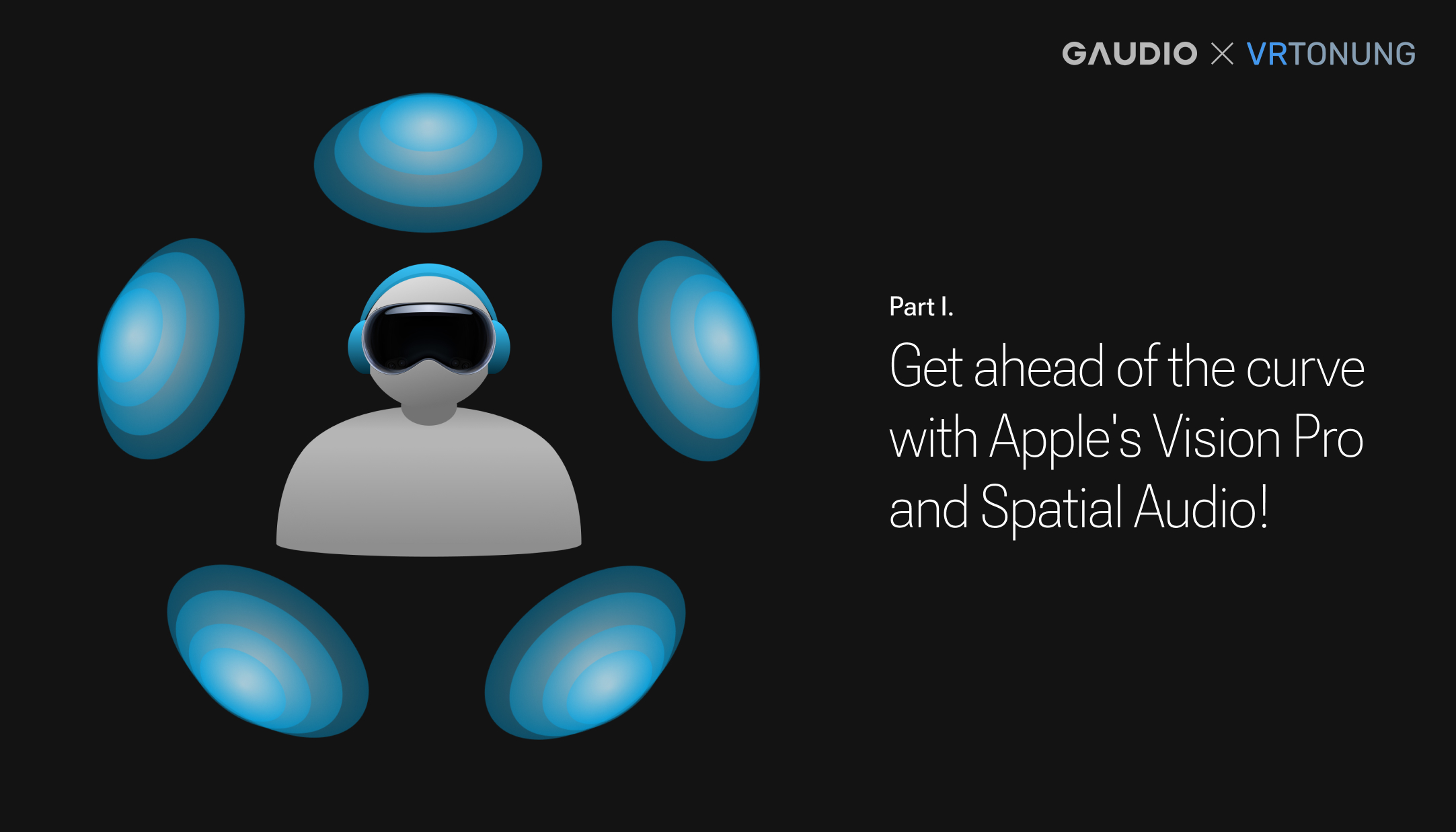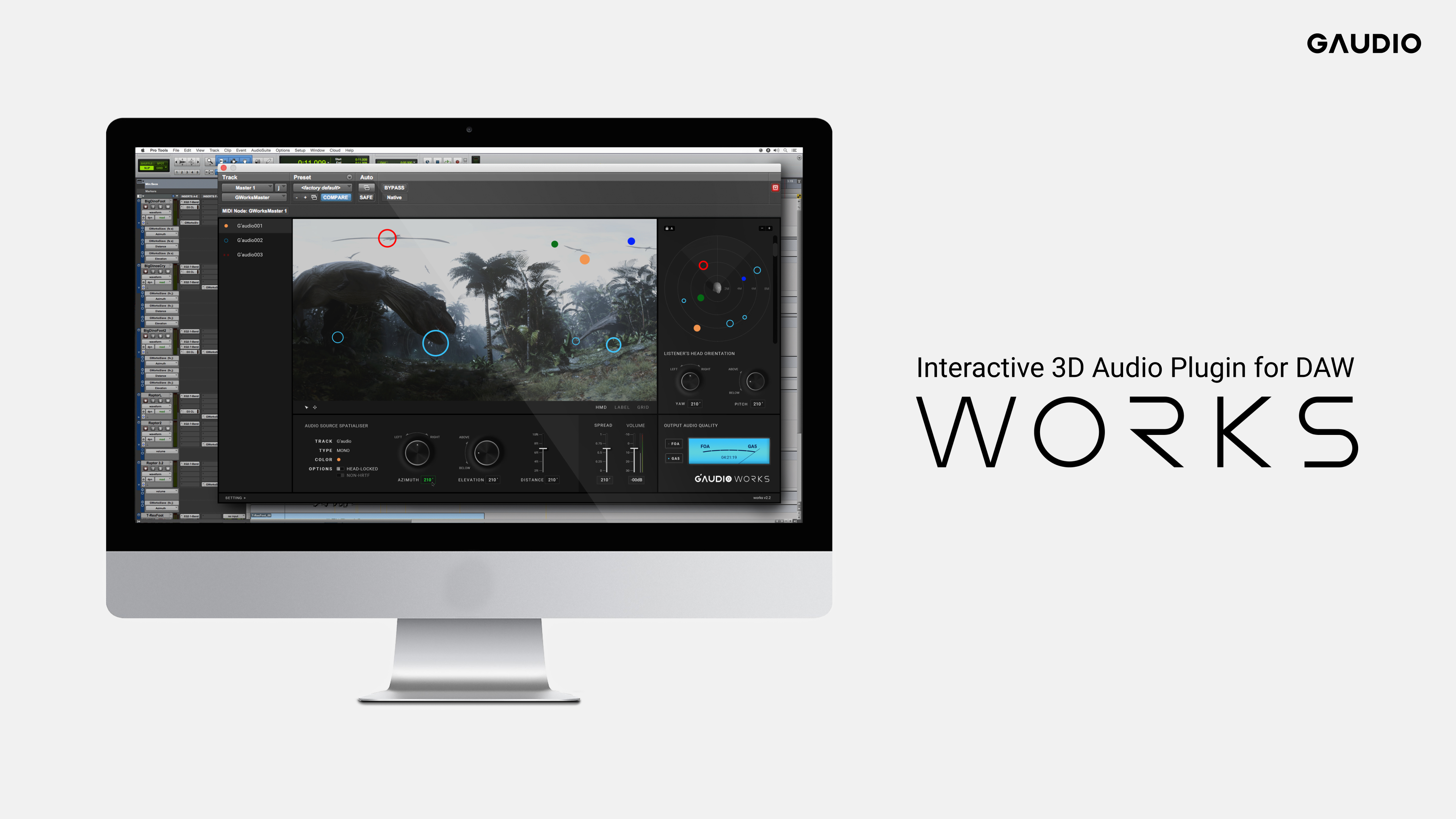Get ahead of the curve with Apple's Vision Pro and spatial audio! [Part1]
Intro: Get ahead of the curve with Apple's Vision Pro and spatial audio!

Do you ever wish for a more complete sound experience? Have you heard of something called spatial audio, and wondered what the hype is all about? If so, then this blog post can answer your questions! Follow this conversation of two industry pioneers Ben Chon from Gaudio Lab and Martin Rieger - who have been hard at work pushing the boundaries of audio technology.
What we are currently witnessing is an exciting new era for applications specifically designed to utilize spatial audio. You will learn how these developments promise to bring us much closer to having true 360° immersive sound experiences - those that make us feel truly present in our digital domain!
With the recent announcement of Apple's Vision Pro, it's easy to get swept up in the hype. As we all eagerly awaited Apple's next big thing, the "immersive" experience promises seem to be more than just marketing talk. One of the most exciting features of the Vision Pro is the introduction of spatial audio, which has been hailed as a game-changer for the world of VR and AR.
It's clear that the arrival of Apple's Vision Pro is going to be a massive step forward for immersive technology, and also the stock price has reached new highs.
Prepare yourself for a journey into the world of 3D Audio; buckle up because this is where it gets really interesting.
Spatial Audio spreading over industries
Martin: Hi, I am an enthusiastic and knowledgeable 3D audio expert named Martin Rieger. I specialize in immersive audio productions and am proud to be one of the few experts who work full-time in recording, post-production, and consulting. My studio, VRTonung, and dedicated blog showcase the incredible possibilities of spatial computing technology when used with creativity.
Being an active member of the audio engineering society, I attended AES Dublin years ago where I had the pleasure of meeting Ben from Gaudio Lab. Since then, we have stayed in touch, discussing the latest developments in spatial audio technologies. So we thought it'd be fun to come back together and discuss the spatial computing revolution.
360 degrees videos are underrated
I am truly passionate about my field and always strive to create something unique that wouldn't have been possible in stereo. While I appreciate films and music in formats like Dolby Atmos or Sony 360 Reality, I think they don't add too much value for spatial technology. So I'm also a big critic of the whole trend of making everything spatial audio for the sake of it. But more on this where I see the true spatial audio potential later.
My personal favorites are still 360 videos, which I believe are still quite underrated and haven't been utilized to their full potential mostly. In these immersive videos, sound plays a crucial role in guiding users' attention by utilizing head-tracking. Additionally, combining the sound with head-locked stereo elements such as narrators or background music enhances the immersive experience and contributes to a captivating 360 soundtrack. By incorporating multichannel recordings like Ambisonics, we unlock what I'd consider a truly immersive audio experience.
Elements for a truly immersive audio experience
This is where I appreciated the workflow by Gaudio Works, having all of these three elements:
- an objects-based approach to pan mono sounds in space,
- an ambisonics bed for recordings of reverbs and
- a head-locked stereo track.
This non-spatial track, which plays independently from where people are looking to, is missing in popular formats such as AC-4, making it useless for podcasts of radio dramas in my opinion.
With Gaudio Lab's works, I created the mix for a German premium furniture client. Janua's 360° VR experience, takes showcasing furniture to an entirely new level! The VR project gives us an inside look at the stories behind our creations, giving viewers an emotional connection to furniture.
“I really liked mixing with Gaudio Works since it just felt like the developers put a lot of thought into the software. I’m not aware of any spatializer plugin for DAWs that allows rotating the equirectangular view or a timbre correction. I could even mix remotely on my laptop and transported easily to the Oculus Go that we were using back then”
Ben: Hi, I'm Ben from Gaudio Lab. At Gaudio Lab, I've led research and development efforts for spatial audio product families, including Works—an immersive audio post-production tool for 360 videos, Craft—a 6-DOF (Degrees of Freedom) immersive audio game engine plugin for Unity and Unreal, and GSA (Gaudio Spatial Audio)—a headtracking spatial audio rendering SDK for TWS.
Gaudio Works, an immersive audio post-production tool tailored for enhancing 360 videos

I'm thrilled that you've enjoyed using Gaudio Works for mixing. We designed and developed Works based on three key principles.
First, it's crucial to support a wide range of technologies to enable sound engineers to create the most exceptional sound experiences ever available in 360 videos. Through collaborations with mainstream Hollywood studios and small studios dedicated to 360 videos, we've learned about production-side needs. Supporting object, channel, ambisonics, and non-diegetic signals is one of the valuable lessons we've learned.
Second, the tools should provide binaural rendering that sounds as natural as possible or, at the very least, offer a means to control the balance between immersiveness and naturalness. While numerous technologies with binaural rendering filters exist, we often hear artifacts from binaural filtering, especially when the filter has a long reverberant time. We've strived to design the binaural filter to have timbral changes as minimal as possible and have also incorporated a feature called "binaural strength." This empowers sound engineers to control the filter intensity for each sound element.
Third, ease of use is essential for the tool. Works adopted spherical coordinates (r, θ, ϕ) instead of rectangular coordinates (x, y, z) and provided both equirectangular and head-mounted display (HMD) views. Many pioneers in the VR scene have embraced Gaudio Works, leading Gaudio to win the "Innovative VR Company of the Year" at the AMD VR Awards in 2017.


The Winner of VR Awards 2017, Gaudio Lab
What even is spatial audio, AR “Headtracking”
Martin: Spatial audio is a fascinating technology that has the power to completely transform our listening experiences. However, it's frustrating when discussions about spatial audio only focus on its role in films and music, as if these are the only areas where it's relevant with formats such as Dolby Atmos.
The truth is, spatial audio has the potential to revolutionize many areas of our lives, particularly in the realm of spatial computing, where it can push the boundaries of what's possible. Understanding how spatial audio needs to be approached differently in 0DoF, 3DoF, and 6DoF is crucial for anyone interested in this exciting technology. DoF stands for degrees of freedom and here is a little overview to give you ideas on how surround sound can be used here:
- 0DoF: Movies, Music, and Podcasts applications. You are not supposed to move your head and just watch the front. This is where most of the sound waves are coming from
- 3DoF: 360 Videos and AR Headphones. You can enable head movement and the soundfield around you adapts in real time. The directional audio filters help you to localize sound
- 6DoF: Extended Reality (Virtual Reality, Augmented Reality), Spatial Computing. You are in a 3D digital world and can even move toward sound. Similar to gaming applications
So let's dive in and explore the future of spatial audio with multiple degrees of freedom beyond the confines of traditional media.
Immersive audio isn't necessarily "immersive"
As we navigate through the world of audio, we often hear chatter about the elusive and wondrous "immersive audio" experience. While it certainly has its place, we must not forget that stereo and even mono can be just as impactful when accompanied by engaging content. The key is to find that sweet spot where sound and visuals align in a perfect union. This is where spatial audio comes in for spatial computing. When executed correctly, it can transport us to another world entirely, regardless of the number of channels involved.
Many game developers believe that incorporating audio into their game is as simple as checking off a 3D audio box and calling it a day. However, truly immersive audio requires careful consideration and utilization of spatial audio technology. By neglecting this crucial aspect of sound design, developers are missing out on the potential impact that audio can have on a player's overall gaming experience. Such aspects for spatial audio support include:
- did you match the frequency curve of sounds you randomly took from SFX library before implementing them into your game engine?
- did you add context to the sound effect like background a surround sound or reverberation to make your audio object blend into your virtual world?
- did you sort the layers of your soundtrack like voice, music, and sound effects, and distinguish between diegetic and non-diegetic elements?
Head tracking is great when done right
For audiophiles like me, the experience of immersive soundscapes is nothing short of a thrill ride. With platforms like YouTube360 or Facebook360, it's easy to achieve that through Ambisonics audio. But anything below second-order ambisonics may disappoint. Since the spatial resolution could be too diffuse on such social media platforms. So if you are like me, you're yearning for a more object-based approach already common in the Apple Music app to support spatial audio.
That is why I can't help but wish for something more advanced - something that can capture the nuances of sounds more faithfully. If you've been following the latest advancements in technology, you might have heard of the integration of head-tracking into AR headphones - namely, Airpods. As a professional in the field of audio and video production, I've adapted my knowledge within 360 videos to this new form of AR audio. It's an exciting time for the industry, with Apple leading the charge and Android catching up quickly with products like the Galaxy Buds Pro2 or Pixel Buds Pro.
Why Dolby Atmos tracks are a danger for immersive podcasts
Despite all the hype surrounding Dolby Atmos technology, there is one major flaw that could be a major danger for immersive podcasts – the lack of head-locked audio. The format is designed to be listened to facing forward, just like a cinema screen or TV, leaving no room for head-tracking.
This means that any audio mixing done in this format will ultimately lack the crucial element for creating truly spatial audio. Incorporating non-diegetic audio such as background music or most importantly a narrator voice-over. It's a pity that so many podcasts and even Audible are jumping on the Dolby Atmos bandwagon without considering the limitations of the technology, especially since it touts itself as being future-proof. This is exactly why I dig Apple's spatial audio approach with its RealityKitpro and the three elements of an immersive soundtrack as listed above.
Story will be continued to the next post


